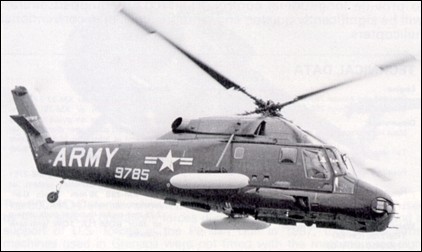
| Kaman H-2 "Tomahawk" 1959 |  |
 |

| Kaman H-2 "Tomahawk" 1959 |  |
 |
|
Originally developed in response to a 1958 U.S.Navy requirement for a ship-based light utility helicopter, the UH-2 first came to the Army's attention in September 1963. Earlier that year the Army had allocated some $4 million for the development of the world's first purpose-built attack helicopter, and at the same time solicited tenders for a low-cost interim gunship that could be used until the more advanced aircraft became available. Kaman had anticipated the Army's need for a stop-gap attack craft and had developed a low-cost design based on the existing Navy UH-2A "Seasprite". The single interim gunship prototype was handed over to the Army Aviation Test Board for evaluation in October 1963. The UH-2A interim attack helicopter, which the Army designated H-2 "Tomahawk", differed from the standard Navy Seasprite in several ways. The most obvious difference was in armament, for the Tomahawk was fitted with two chin-mounted turrets, each housing two 7.62mm machine guns. The turrets could be operated independently of one another, or could be 'slaved' together to engage the same target. The aircraft also carried a single door-mounted M-60 machine gun, and was fitted with short stub wings upon which could be carried up to four 7-round pods of 2.75 inch unguided rockets. Other modifications made to the H-2 included the addition of armor plating around the cockpit, engine, transmission, and fuel tanks, and the installation of Army-standard navigation and communications equipment. The Aviation Test Board ultimately judged the Tomahawk to be an extremely capable machine, and in early November 1963 the Army sought and received Congressional authorization to purchase 220 aircraft. However, five days after the 22 November assassination of John Kennedy and the subsequent assumption of the Presidency by Texan Lyndon Johnson the acquisition of the Connecticut-built H-2 was ordered abandoned in favor of further purchases of the Texas-built Bell UH-1 "Iroquois".
|